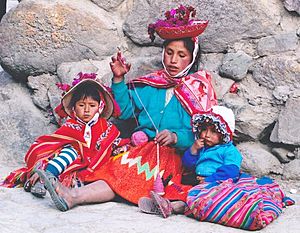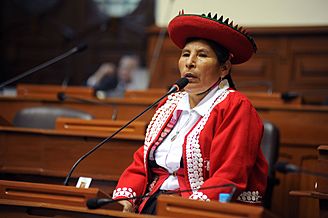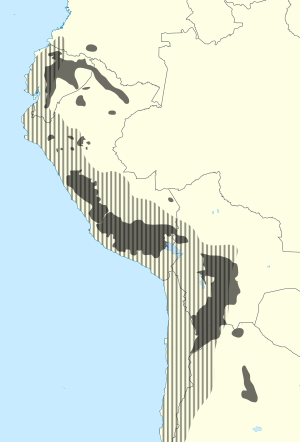Quechua people facts for kids
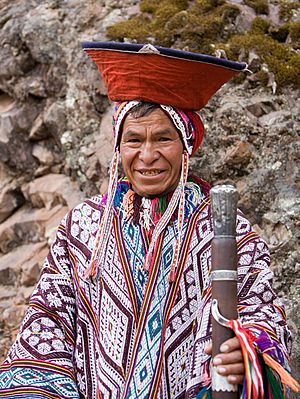
An Andean man in traditional dress. Pisac, Peru.
|
|
| Total population | |
|---|---|
| 9–8 million | |
| Regions with significant populations | |
| 6,694,300 | |
| 2,056,000 | |
| 700.000 | |
| 55.493 | |
| 36 700 | |
| 14,000 | |
| Languages | |
| Quechua • Spanish | |
| Religion | |
| Roman Catholicism • Protestantism • Traditional | |
| Related ethnic groups | |
| Aymaras | |
| person | |
| people | |
| language |
Quechua people (/ˈkɛtʃuə/, US also /ˈkɛtʃwɑː/; Spanish: [ˈketʃwa]) or Quichua people may refer to any of the indigenous peoples of South America who speak the Quechua languages, which originated among the Indigenous people of Peru. Although most Quechua speakers are native to Peru, there are some significant populations in Ecuador, Bolivia, Chile, Colombia, and Argentina.
The most common Quechua dialect is Southern Quechua. The Kichwa people of Ecuador speak the Kichwa dialect; in Colombia, the Inga people speak Inga Kichwa.
The Quechua word for a Quechua speaker is runa or nuna ("person"); the plural is runakuna or nunakuna ("people"). "Quechua speakers call themselves Runa -- simply translated, 'the people.'"
Some historical Quechua people are:
- The Chanka people, who lived in the Huancavelica, Ayacucho, and Apurímac regions of Peru.
- The Huanca people of the Junín Region of Peru, who spoke Quechua before the Incas did.
- The Inca, who established the largest empire of the pre-Columbian era.
- The Chincha, an extinct merchant kingdom of the Ica Region of Peru.
- The Qolla who inhabited the Potosí, Oruro, and La Paz departments of Bolivia.
- The Cañari of Ecuador, who adopted the Quechua language from the Inca.
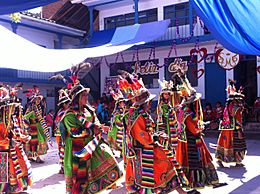
Contents
Historical and sociopolitical background
The speakers of Quechua, totaling some 5.1 million people in Peru, 1.8 million in Bolivia, 2.5 million in Ecuador (Hornberger and King, 2001), and according to Ethnologue (2006) 33,800 in Chile, 55,500 in Argentina, and a few hundred in Brazil, have an only slight sense of common identity. The various Quechua dialects are in some cases so different that no mutual understanding is possible. Quechua was not only spoken by the Incas, but also by long-term enemies of the Inca Empire, like the Huanca (Wanka is a Quechua dialect spoken today in the Huancayo area) and the Chanka (the Chanca dialect of Ayacucho) of Peru, and the Kañari (Cañari) in Ecuador. Quechua was spoken by some of these people, for example, the Wanka, before the Incas of Cusco, while other people, especially in Bolivia but also in Ecuador, adopted Quechua only in Inca times or afterward.
Quechua became Peru's second official language in 1969 under the military dictatorship of Juan Velasco Alvarado. Recently there have been tendencies toward nation building among Quechua speakers, particularly in Ecuador (Kichwa) but also in Bolivia, where there are only slight linguistic differences from the original Peruvian version. An indication of this effort is the umbrella organization of the Kichwa peoples in Ecuador, ECUARUNARI (Ecuador Runakunapak Rikcharimuy). Some Christian organizations also refer to a "Quechua people", such as the Christian shortwave radio station HCJB, "The Voice of the Andes" (La Voz de los Andes). The term "Quechua Nation" occurs in such contexts as the name of the Education Council of the Quechua Nation (Consejo Educativo de la Nación Quechua, CENAQ), which is responsible for Quechua instruction or bilingual intercultural schools in the Quechua-speaking regions of Bolivia. Some Quechua speakers claim that if nation states in Latin America had been built following the European pattern, they should be a single, independent nation.
Material culture and social history
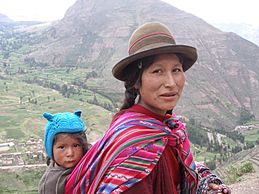
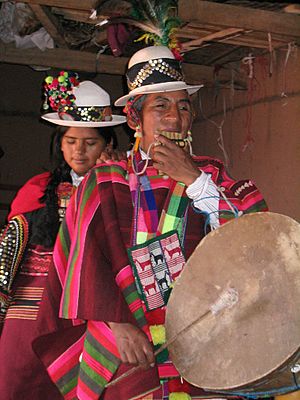
Despite their ethnic diversity and linguistic distinctions, the various Quechua ethnic groups have numerous cultural characteristics in common. They also share many of these with the Aymara or other Indigenous peoples of the central Andes.
Traditionally, Quechua identity is locally oriented and inseparably linked in each case with the established economic system. It is based on agriculture in the lower altitude regions, and on pastoral farming in the higher regions of the Puna. The typical Andean community extends over several altitude ranges and thus includes the cultivation of a variety of arable crops and/or livestock. The land is usually owned by the local community (ayllu) and is either cultivated jointly or redistributed annually.
Beginning with the colonial era and intensifying after the South American states had gained their independence, large landowners appropriated all or most of the land and forced the Native population into bondage (known in Ecuador as Huasipungo, from Kichwa wasipunku, "front door"). Harsh conditions of exploitation repeatedly led to revolts by the Indigenous farmers, which were forcibly suppressed. The largest of these revolts occurred 1780–1781 under the leadership of José Gabriel Kunturkanki.
Some Indigenous farmers re-occupied their ancestors' lands and expelled the landlords during the takeover of governments by dictatorships in the middle of the 20th century, such as in 1952 in Bolivia (Víctor Paz Estenssoro) and 1968 in Peru (Juan Velasco Alvarado). The agrarian reforms included the expropriation of large landowners. In Bolivia there was a redistribution of the land to the Indigenous population as their private property. This disrupted traditional Quechua and Aymara culture based on communal ownership, but ayllus have been retained up to the present time in remote regions, such as in the Peruvian Quechua community of Q'ero.
The struggle for land rights continues up to the present time to be a political focal point of everyday Quechua life. The Kichwa ethnic groups of Ecuador which are part of the ECUARUNARI association were recently able to regain communal land titles or the return of estates—in some cases through militant activity. Especially the case of the community of Sarayaku has become well known among the Kichwa of the lowlands, who after years of struggle were able to successfully resist expropriation and exploitation of the rain forest for petroleum recovery.
A distinction is made between two primary types of joint work. In the case of mink'a, people work together for projects of common interest (such as the construction of communal facilities). Ayni is, in contrast, reciprocal assistance, whereby members of an ayllu help a family to accomplish a large private project, for example house construction, and in turn can expect to be similarly helped later with a project of their own.
In almost all Quechua ethnic groups, many traditional handicrafts are an important aspect of material culture. This includes a tradition of weaving handed down from Inca times or earlier, using cotton, wool (from llamas, alpacas, guanacos, and vicunas) and a multitude of natural dyes, and incorporating numerous woven patterns (pallay). Houses are usually constructed using air-dried clay bricks (tika, or in Spanish adobe), or branches and clay mortar ("wattle and daub"), with the roofs being covered with straw, reeds, or puna grass (ichu).
The disintegration of the traditional economy, for example, regionally through mining activities and accompanying proletarian social structures, has usually led to a loss of both ethnic identity and the Quechua language. This is also a result of steady migration to large cities (especially to Lima), which has resulted in acculturation by Hispanic society there.
Foods and crops
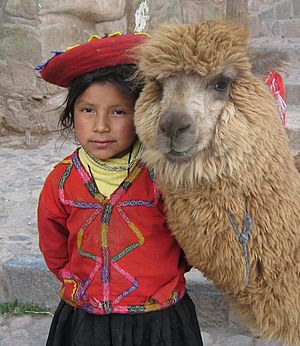
Quechua peoples cultivate and eat a variety of foods. They domesticated potatoes and cultivate thousands of potato varieties, which are used for food and medicine. Climate change is threatening their potato and other traditional crops but they are undertaking conservation and adaptation efforts. Quinoa is another staple crop grown by Quechua peoples.
Ch’arki (the origin of the English word jerky) is a Quechua dried (and sometimes salted) meat. It was traditionally made from llama meat that was sun- and freeze-dried in the Andean sun and cold nights, but is now also often made from horse and beef, with variation among countries.
Pachamanca, a Quechua word for a pit cooking technique used in Peru, includes several types of meat such as chicken, beef, pork, lamb, and/or mutton; tubers such as potatoes, sweet potatoes, yucca, uqa/ok’a (oca in Spanish), and mashwa; other vegetables such as maize/corn and fava beans; seasonings; and sometimes cheese in a small pot and/or tamales.
Guinea pigs are also sometimes raised for meat. Other foods and crops include the meat of llamas and alpacas as well as beans, barley, hot peppers, coriander, and peanuts.
Examples of recent persecution of Quechuas
Up to the present time Quechuas continue to be victims of political conflicts and ethnic persecution. In the internal conflict in Peru in the 1980s between the government and Sendero Luminoso about three-quarters of the estimated 70,000 death toll were Quechuas, whereas the war parties were without exception whites and mestizos (people with mixed descent from both Natives and Spaniards).
Quechuas have been left out of their nation's regional economic growth in recent years. The World Bank has identified eight countries on the continent to have some of the highest inequality rates in the world. The Quechuas have been subject to these severe inequalities, as many of them have a much lower life expectancy than the regional average, and many communities lack access to basic health services.
Perceived ethnic discrimination continues to play a role at the parliamentary level. When the newly elected Peruvian members of parliament Hilaria Supa Huamán and María Sumire swore their oath of office in Quechua—for the first time in the history of Peru in an Indigenous language—the Peruvian parliamentary president Martha Hildebrandt and the parliamentary officer Carlos Torres Caro refused their acceptance.
Mythology
Practically all Quechuas in the Andes have been nominally Catholic since colonial times. Nevertheless, traditional religious forms persist in many regions, blended with Christian elements – a fully integrated syncretism. Quechua ethnic groups also share traditional religions with other Andean peoples, particularly belief in Mother Earth (Pachamama), who grants fertility and to whom burnt offerings and libations are regularly made. Also important are the mountain spirits (apu) as well as lesser local deities (wak'a), who are still venerated especially in southern Peru.
The Quechuas came to terms with their repeated historical experience of tragedy in the form of various myths. These include the figure of Nak'aq or Pishtaco ("butcher"), the white murderer who sucks out the fat from the bodies of the Indigenous peoples he kills. In their myth of Wiraquchapampa, the Q'ero people describe the victory of the Apus over the Spaniards. Of the myths still alive today, the Inkarrí myth common in southern Peru is especially interesting; it forms a cultural element linking the Quechua groups throughout the region from Ayacucho to Cusco. Some Quechuas consider classic products of the region such as corn beer, chicha, coca leaves, and local potatoes as having a religious significance, but this belief is not uniform across communities.
Contribution in modern medicine
Quinine, which is found naturally in bark of cinchona tree, is known to be used by Quechuas people for malaria-like symptoms.
When chewed, coca acts as a mild stimulant and suppresses hunger, thirst, pain, and fatigue; it is also used to alleviate altitude sickness. Coca leaves are chewed during work in the fields as well as during breaks in construction projects in Quechua provinces.
Traditional clothing

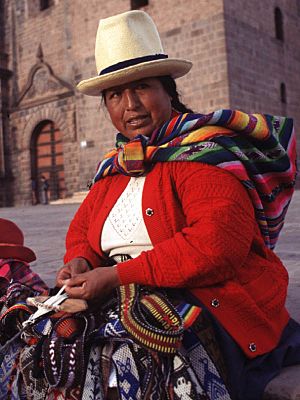
Many Indigenous women wear the colorful traditional attire, complete with bowler style hat. The hat has been worn by Quechua and Aymara women since the 1920s, when it was brought to the country by British railway workers. They are still commonly worn today.
The traditional dress worn by Quechua women today is a mixture of styles from Pre-Spanish days and Spanish Colonial peasant dress. Starting at puberty, Quechua girls begin wearing multiple layers of petticoats and skirts; the more petticoats and skirts worn by a young woman, the more desirable a bride she would be, due to her family's wealth (represented by the number of petticoats and skirts). Married women also wear multiple layers of petticoats and skirts. Younger Quechua men generally wear Western-style clothing, the most popular being synthetic football shirts and tracksuit pants. In certain regions, women also generally wear Western-style clothing. Older men still wear dark wool knee-length handwoven bayeta pants. A woven belt called a chumpi is also worn which provides protection to the lower back when working in the fields. Men's fine dress includes a woollen waistcoat, similar to a sleeveless juyuna as worn by the women but referred to as a chaleco. Chalecos can be richly decorated.
The most distinctive part of men's clothing is the handwoven poncho. Nearly every Quechua man and boy has a poncho, generally red in colour decorated with intricate designs. Each district has a distinctive pattern. In some communities such as Huilloc, Patacancha, and many villages in the Lares Valley ponchos are worn as daily attire. However most men use their ponchos on special occasions such as festivals, village meetings, weddings etc.
As with the women, ajotas, sandals made from recycled tyres, are the standard footwear. They are cheap and durable.
A ch'ullu is frequently worn. This is a knitted hat with earflaps. The first ch'ullu that a child receives is traditionally knitted by his father. In the Ausangate region chullos are often ornately adorned with white beads and large tassels called t'ikas. Men sometimes wear a felt hat called a sombrero over the top of the ch'ullu decorated with centillo, finely decorated hat bands. Since ancient times men have worn small woven pouches called ch'uspa used to carry their coca leaves.
Quechua-speaking ethnic groups
The following list of Quechua ethnic groups is only a selection and delimitations vary. In some cases these are village communities of just a few hundred people, in other cases ethnic groups of over a million.
- Inca (historic)
Peru
Lowlands
- Kichwa-Lamista
- Southern Pastaza Quechua
Highlands
Ecuador
- Amazonian Kichwas
- Otavalos
- Salasaca
Bolivia
- Kolla
- Kallawaya
Notable people
- Túpac Amaru II, Revolutionary
- Angélica Mendoza de Ascarza, Human rights activist
- Kimberly Barzola, community organizer and artist
- Benjamin Bratt, Peruvian-American actor
- Manco Cápac, Sapa Inca
- Martín Chambi, Photographer
- Edison Flores, Footballer
- Oswaldo Guayasamín, Ecuadorian painter
- Ollanta Humala, former President of Peru
- Izkia Siches, doctor, Chilean politician
- Josh Keaton, Peruvian-American actor
- Q'orianka Kilcher, Actress
- Magaly Solier, Actress
- Diego Quispe Tito, Painter
- Alejandro Toledo, former President of Peru
- Juan Manuel Vargas, Footballer
- Yoshimar Yotún, Footballer
- Francisco Tito Yupanqui, Sculptor, Saint
- Luzmila Carpio, Musician, Activist
- Rodrigo Cuba, footballer
- Delfín Quishpe, musician, Ecuadorian politician
- Iván Kaviedes, footballer
- José Granda, footballer
- Luis Saritama, footballer
- Joao Ortiz Chilean-Peruvian footballer
- Miguel Vargas, Chilean-Peruvian footballer
- Renata Flores Rivera, Musician
See also
- Kichwa
- Inkarrí
- Yanantin
- Sumak Kawsay
- Andean textiles
- Chuspas
- Chakitaqlla
- Chinchaypujio District
- Quechuan languages
- Indigenous peoples in Argentina
- Indigenous peoples in Bolivia
- Indigenous peoples of Peru
- Indigenous peoples in Ecuador


